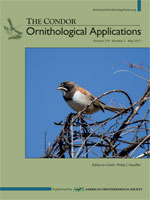Understanding the catchment areas of key stopover sites for migratory birds is important for their management and conservation. The Saskatchewan River Delta (SRD) in central Canada is North America's largest inland delta and an important spring and fall stopover site for migratory waterfowl, but there is little information on the origins of waterfowl that use the SRD. We used stable isotope analyses of hydrogen (δ2H) and sulfur (δ34S) in feathers of hunter-killed waterfowl on the SRD to infer natal or molt origins of 5 duck species, using spatially explicit assignment to a δ2H feather isoscape developed for waterfowl in North America. Initial classification with δ2H estimated that 50% were migrants from the north and 10% were assigned to regions south of the SRD, leaving only 39% of the sample with origins in the SRD. Using thresholds in feather δ34S values associated with prairie and forest biomes, we further reassigned 64% of SRD birds as having originated from nearby agricultural and forested areas that have similar δ2H values as the delta. Together, these results suggest that >80% of all waterfowl sampled were recent arrivals that were using the SRD as a stopover site. This demonstrates that stable isotope analyses of hunter-killed birds can be used to monitor changes in origins and recruitment into the fall waterfowl population of key stopover sites.
How to translate text using browser tools
19 April 2017
Tracing origins of waterfowl using the Saskatchewan River Delta: Incorporating stable isotope approaches in continent-wide waterfowl management and conservation
Christian K. Asante,
Timothy D. Jardine,
Steven L. Van Wilgenburg,
Keith A. Hobson
ACCESS THE FULL ARTICLE

The Condor
Vol. 119 • No. 2
May 2017
Vol. 119 • No. 2
May 2017
American Wigeon
Blue-winged Teal
deuterium
green-winged teal
mallard
migration
northern pintail




